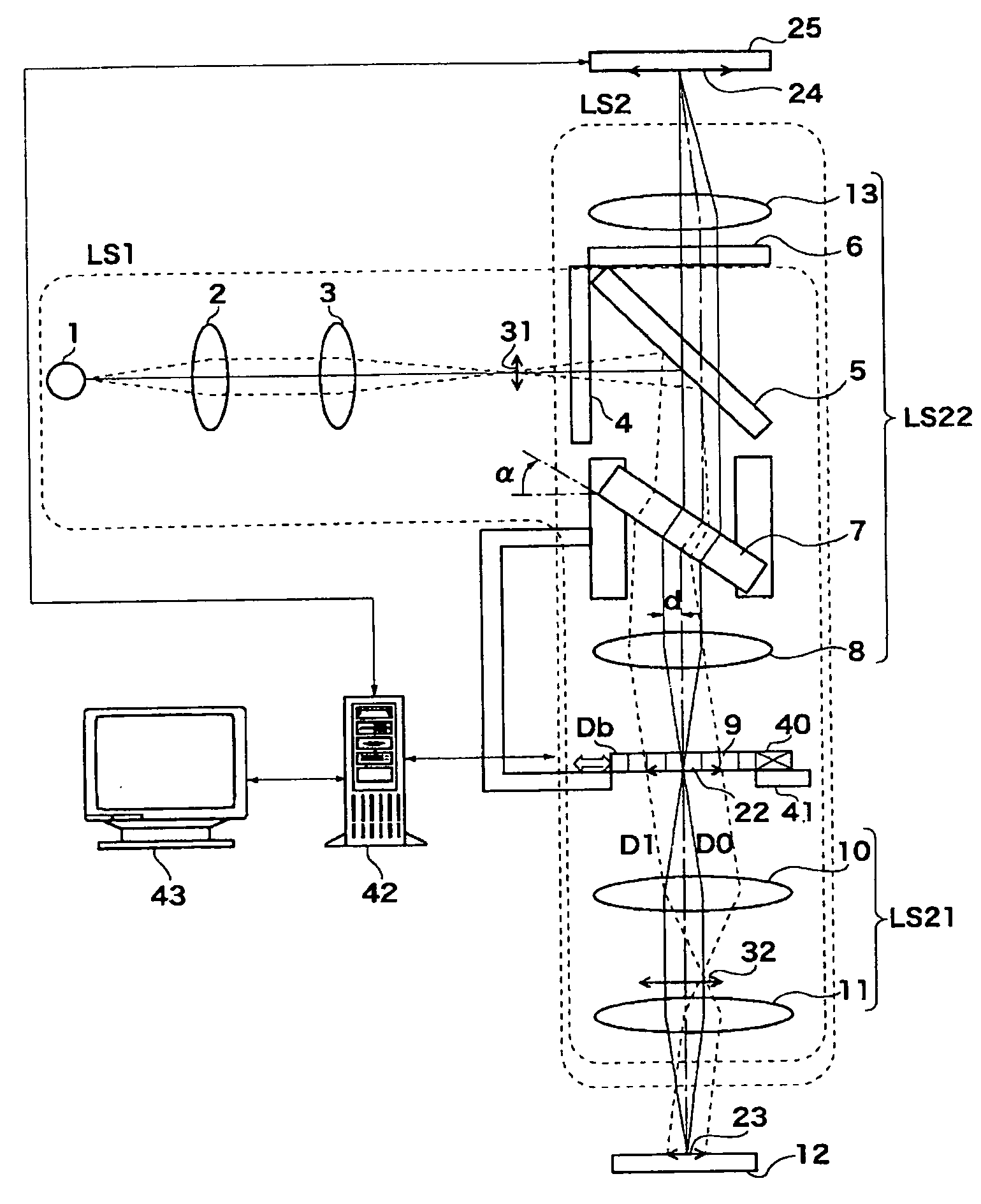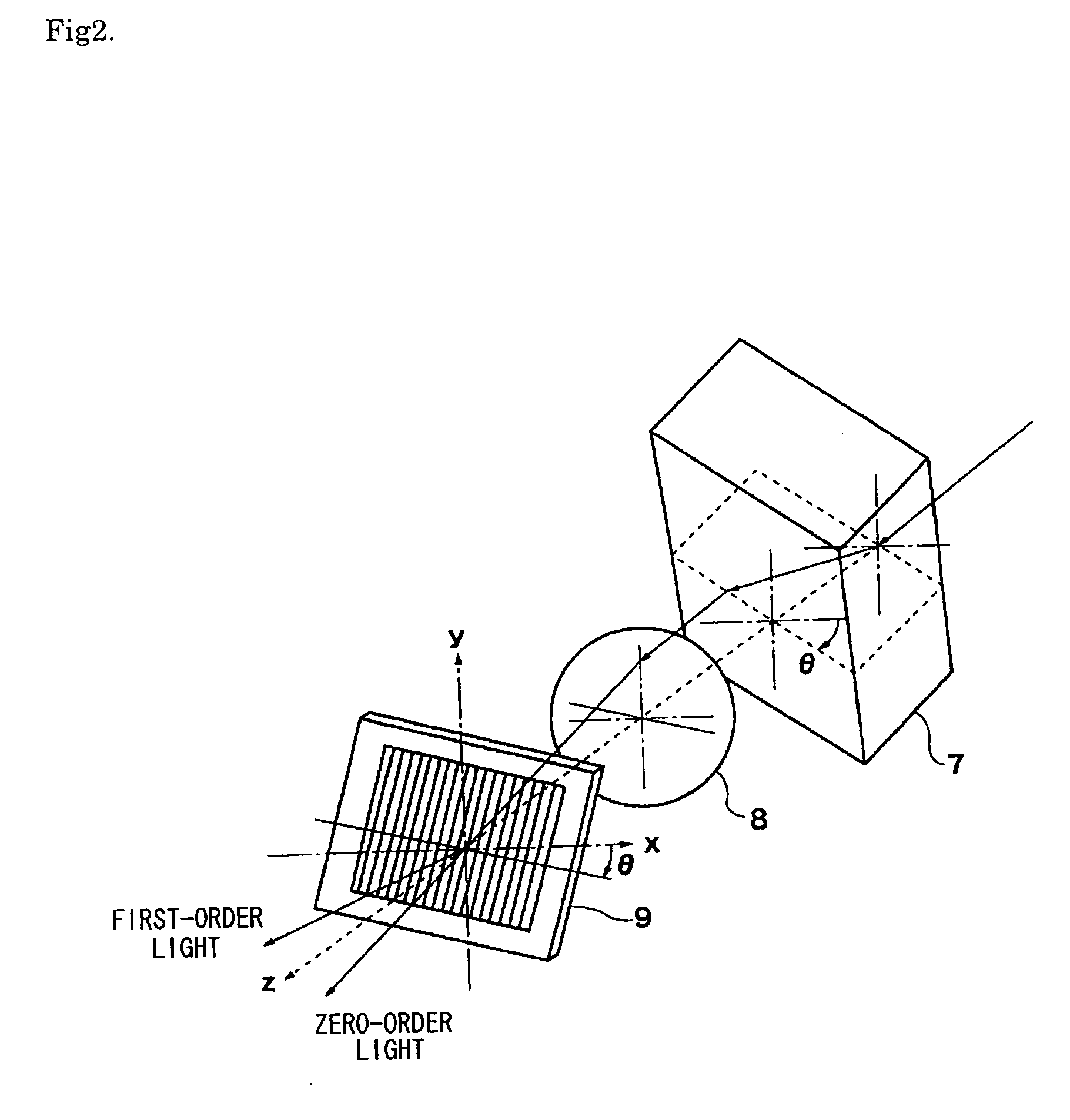Microscope device and image processing method
a microscope and image processing technology, applied in the field of microscope devices and image processing methods, can solve the problems of hardly observing objects in real time, hardly obtaining good super-resolution images, and taking time for computer demodulation, etc., and achieve the effect of high speed
- Summary
- Abstract
- Description
- Claims
- Application Information
AI Technical Summary
Benefits of technology
Problems solved by technology
Method used
Image
Examples
first embodiment
[0083]Exemplary embodiments of the invention will be described with reference to the drawings. FIG. 1 is a view showing an outline of an optical system of a microscope apparatus according to the invention. The microscope apparatus includes a light source 1, a collector lens 2, a collimator lens 3, an exciter filter 4, a dichroic mirror 5, a barrier filter 6, a parallel-plate glass 7 which is of an optical path moving optical system, a lens 8 which is of an illumination optical system, a diffraction grating 9 which is of a spatial modulation element, a second objective lens 10, a first objective lens 11, a lens 13, an image picking-up device (such as a CCD camera) 25, a control and operation device (such as a circuit and a computer) 42, an image display device 43, an actuator 40, and a rotary stage 41. In the microscope apparatus, an image formed by fluorescence generated from a specimen (fluorescent sample) 12 is taken by the image picking-up device 25 for processing.
[0084]The light...
second embodiment
[0107]FIG. 3 is a view showing an outline of an optical system of a microscope apparatus according to the invention.
[0108]The second embodiment of the invention will be described below. In the following drawings, the same component as that shown in the drawings is designated by the same numeral, and sometimes the description is omitted. The second embodiment differs from the first embodiment in that the parallel-plate glass 7 is disposed immediately behind the light source 1. In the first embodiment, the parallel-plate glass 7 is disposed behind the dichroic mirror 5 as shown in FIG. 1. Even in the configuration of FIG. 3, the on-axis ray can be shifted from the optical axis by the parallel-plate glass 7 such that, in the light diffracted by the diffraction grating 9, the zero-order light D0 and the first-order light D1 are symmetrically generated with respect to the optical axis of the objective lens. The necessary shift amount d can be obtained by computation from the wavelength o...
third embodiment
[0113]The motor-driven stage 52 is slid such that each of the parallel-plate glasses 71, 72, and 73 enters the optical path when the angle of the diffraction grating becomes θ1, θ2, and θ3. Therefore, the oblique illumination direction can be selected by selecting one of the parallel-plate glasses 71, 72, and 73 in accordance with the angle at which the rotation of the diffraction grating 9 is stopped. In the third embodiment, when the angles of the parallel-plate glasses 71, 72, and 73 are accurately adjusted at the beginning, advantageously good repeatability is obtained after that.
[0114]FIG. 5 is a view showing an outline of an optical system of a microscope apparatus according to a fourth embodiment of the invention. The fourth embodiment differs from the second embodiment in that an image rotator 14 is disposed instead of the parallel-plate glass 7 of FIG. 3 and the light source 1 is shifted from the optical axis (center axes of the collector lens and collimator lens 3). Theref...
PUM
 Login to View More
Login to View More Abstract
Description
Claims
Application Information
 Login to View More
Login to View More - R&D
- Intellectual Property
- Life Sciences
- Materials
- Tech Scout
- Unparalleled Data Quality
- Higher Quality Content
- 60% Fewer Hallucinations
Browse by: Latest US Patents, China's latest patents, Technical Efficacy Thesaurus, Application Domain, Technology Topic, Popular Technical Reports.
© 2025 PatSnap. All rights reserved.Legal|Privacy policy|Modern Slavery Act Transparency Statement|Sitemap|About US| Contact US: help@patsnap.com



